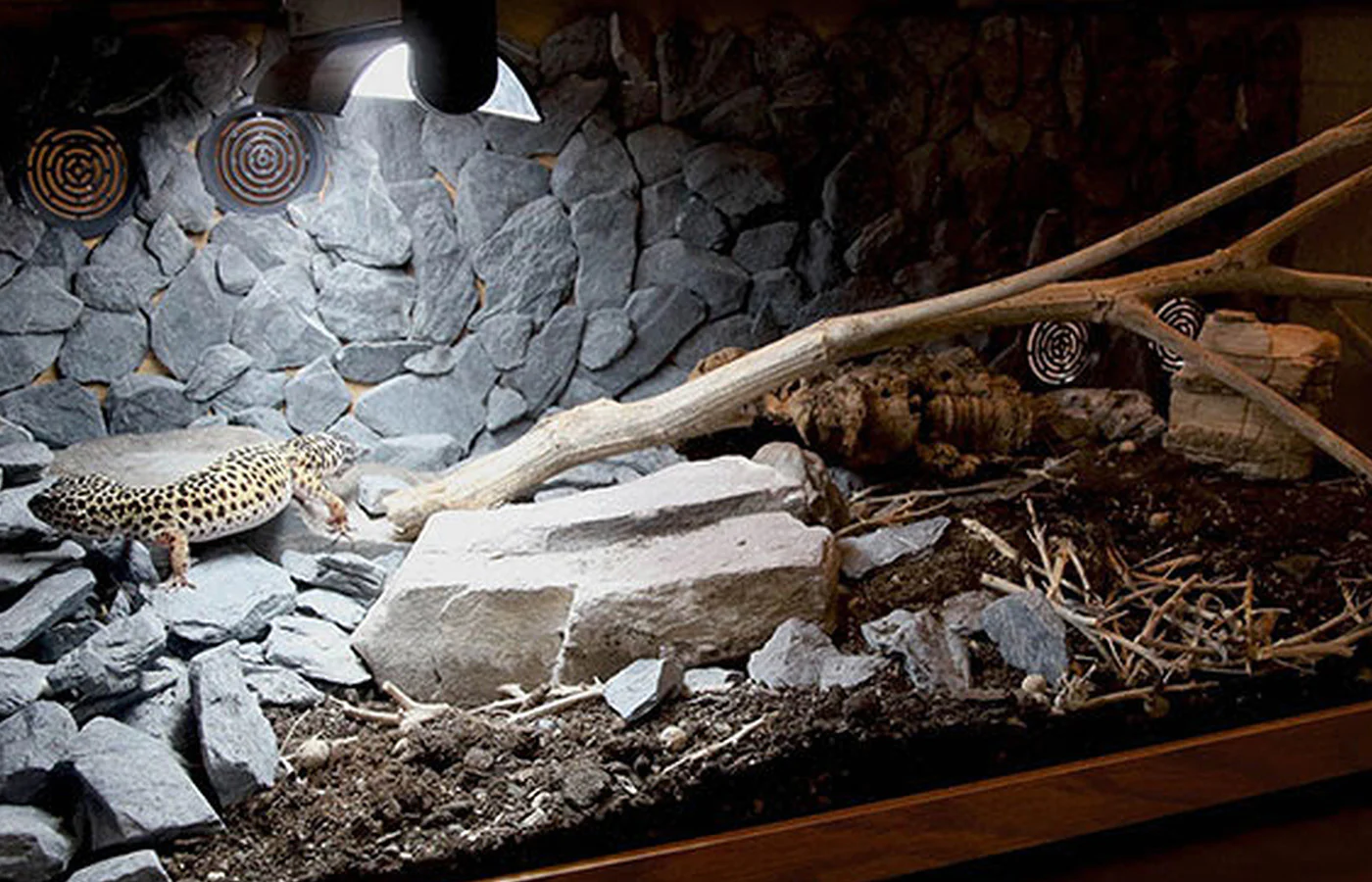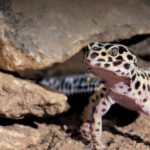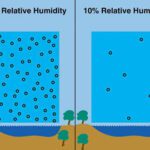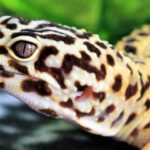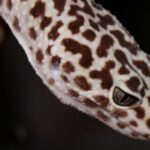Leopard geckos are dependant on day-night cycles. Light can be natural or simulated using artificial light sources. Here we discuss lighting for Leopard geckos.
Table of Contents
Introduction to Leopard gecko lighting
It has been said that there can be no day without night, and there can be no night without day.
Day and night cycles can be created using light. In addition to creating a sensible photoperiod, the correct Leopard gecko lighting can also be used to supply heat and areas to bask in and can improve the aesthetic appearance of terrariums during the day or at night.
In nature, Leopard geckos are mainly active during the hours of dusk, dawn and during evenings. In other words, during times where the light intensity is low and/or there is no light at all. Many Leopard geckos are kept without any form of lighting, but by supplying light, their environment and activities can be made more natural.
The topic of supplying ultraviolet lighting (UVB) is still controversial, but by looking at their natural behaviour, UVB lighting can be used with caution under certain circumstances.
Lighting for Leopard geckos comes in various shapes, types and sizes. The necessity of lighting and the type of lighting used will depend on the type of housing (enclosure) and where it is located. For pet Leopard geckos, lighting is most often supplied artificially using electric light sources. An electrical timer can be used to switch lighting equipment on or off at desired.
Lighting equipment and other Leopard gecko accessories and care items are available online (e.g. Amazon.com), from specialised pet shops and general hardware stores.
Natural Leopard gecko lighting and activity
Various literature sources exist where the time of day, i.e. natural light cycles, are reported to have an effect on the natural behaviour of Leopard geckos.
Leopard geckos live in areas where it is considered to be bright and sunny during the day. Although this is true, these geckos are considered to be crepuscular to nocturnal in nature.
In Pakistan, Leopard geckos were observed to be mostly active during the hours of dusk and dawn — just before sunrise and just after sunset — and during the evenings. Sherman & Minton report them to be strictly nocturnal where Leopard geckos only start to become visible at sunset.
Leopard geckos prefer to spend their days sheltering and hiding under or between rocks or under plants. Although Leopard geckos have been observed basking during the day, it is more important that heat is supplied from below in order for basking to take place. Evening basking will take place on rocks that were heated during the day.
Day and night are not only about light and dark. In nature, there is also a seasonal pattern to how long these periods are — called the photoperiod. As longer nights in winter become shorter in summer, Leopard geckos are able to establish the four seasons of the year.
Also see
Natural distribution of Leopard geckos
Lighting for Leopard geckos can either be direct or indirect, or natural or artificial. The type of lighting used will depend on the size and type of enclosure. Lighting can also be divided into daylight and night light.
Direct vs. indirect lighting
Direct lighting is when there is no obstruction between the light source and the inside of the enclosure. For Leopard geckos, it is best supplied using overhead artificial lighting in the form of incandescent, fluorescent or halogen lamps. Commercial reptile lighting products are preferred over non-commercial or non-specialised ones.
Overhead lighting can either be mounted onto the side of cabinet-like enclosures, into the lid of glass enclosures or placed on top of mesh lids. Ones that are mounted on the inside of enclosures should be mounted securely and placed high up to prevent direct contact with Leopard geckos. Direct lighting can also be placed on top of screen lids or mounted onto a lampstand.
On the other hand, indirect lighting is when there is a barrier, e.g. glass or transparent plastic, separating the light source and the inside of the enclosure, but still allow light to pass through.
A good example of indirect lighting for Leopard geckos would be the light emitted from a lit room. The light in the room can either be natural light shining in from a window or artificial light in the form of electrical light. As the room becomes dark, so does the enclosure.
Natural vs. artificial lighting
Wild Leopard geckos live in environments where they are exposed to sunlight — in other words, natural lighting. Sunlight produces the entire visible light spectrum (including the infrared to ultraviolet waves – see later).
Taking into consideration the risk for overheating and their crepuscular behaviour, direct, natural light (i.e. sunlight) is almost never a good choice when it comes to long a term lighting solution for pet Leopard geckos. Pet Leopard geckos have been reported to get sunburned when exposed to sunlight. Also, placing an enclosure in direct sunlight can lead to temperature spikes which can be life-threatening.
Lighting can also be produced artificially. Artificial light can be produced from sources such as fluorescent tubes, halogen lamps and incandescent bulbs using electricity. It is more practical and much safer than natural lighting and is probably the most common form of lighting for Leopard geckos.
These days, both ultraviolet and infrared waves can be produced artificially using specialised lighting.
Lighting vs. heating
In some cases, a light source can also be used as a heat source. Any light source emitting infrared (IR) waves will produce some degree of heat.
Most artificial light sources will raise the ambient temperature inside an enclosure — at least to some degree. The same goes for night lighting.
Incandescent light bulbs (those with a wire filament that is heated until it glows) are more efficient in producing heat. The higher the power output (in Watt) the more heat will be produced. An incandescent spotlight pointed at a heat-absorbing platform (e.g. a rock) is popularly used to create a basking area for Leopard geckos.
Day vs. night lighting for Leopard geckos
Lighting for Leopard geckos can also be in the form of night light. Special, commercial reptile night lights are available for Leopard geckos. Night lights are said not to interfere with their behaviour and/or affect the overall photoperiod. Night lights can either be used for their night light-emitting properties only, or to supply heat in the process.
While light during the day mimics a more natural environment, night lighting is purely for owners to be able to view the inside of a Leopard gecko’s enclosure. While daylight light rays are visible to people and Leopard geckos, night lights are only visible to people. In other words, while we as humans are able to see night light inside a Leopard gecko’s enclosure, a Leopard gecko will not.
Lighting and photoperiod
Day and night are not only about light and dark — there is also a seasonal photoperiod associated with these times.
The photoperiod is the amount of time per day (in hours and minutes) it is considered to be light (vs. dark). The natural photoperiod for Leopard geckos is more or less 11 hours in winter and 13 hours in summer. This is often better controlled by using an electrical timer switch.
Also see
The photoperiod for Leopard geckos
Ultraviolet (UV) lighting for Leopard geckos
Looking at the visible light spectrum, ultraviolet (UV) rays are those with the shortest wavelengths (280 – 400 nm). Infrared (IR) rays are on the opposite side of this spectrum and are mainly used for emitting heat. Both UV and IR, and all the wavelengths in between, are naturally produced by the sun, but can also be produced artificially using specialised lighting.
UV light can be divided into UVA (315 – 400 nm wavelengths) and UVB (280 – 315 nm wavelengths). UVB is known to play an important role in the production of vitamin D3 in diurnal lizards (mostly active during the day). Vitamin D3 is required for calcium absorption from the intestines and its metabolism.
The common argument about using UV lighting in Leopard geckos is that they are mostly active during, dusk, dawn and the evenings — do they need UV lighting? Another argument is that Leopard geckos have been kept healthy and successfully for generations without UV lighting.
For these reasons, many Leopard gecko keepers prefer not to use UV lighting at all. Others do recommend its use with caution and only under certain circumstances:
- UV lighting should only be used during the day
- UV lamps should be mounted around 30 cm / 12 ” away from the floor of the enclosure
- Low form tubes (in the T8 range) and/or low-intensity UV lights (5-5%) should be used
- Proper hiding areas (“deep dark hides”) isolating the Leopard gecko completely should be supplied
Also see
Leopard gecko hide areas and hide boxes
Thermometers and electrical timers can make lighting equipment easier to use.
Thermometers
Thermometers come in different shapes and sizes and are used to measure temperatures.
Before the installation of lighting equipment is finalised, daytime and nighttime temperatures should be measured in various areas of the enclosure. A thermometer can also be permanently installed on the inside of the enclosure to keep a constant watch on the temperatures. The probe of the thermometer should preferably be inserted into or under the substrate.
The REPTI ZOO Reptile Terrarium thermometer can read the temperatures in the recommended temperature range of Leopard geckos. Available from Amazon.com
Also see
Leopard gecko thermometers
Electrical timers
Electrical timers (or electrical timer switches) can also be used to switch lighting equipment on or off at the desired times.
Zoo Med Repticare Day Night Timer can turn daylights on in the morning and off at night and nightlights on at night and off in the morning. It is perfect for regulating the photoperiod of Leopard geckos. Available from Amazon.com
Also see
Using electrical timers with Leopard geckos
Conclusion
Lighting plays an important part in creating a more natural environment and natural behaviour in Leopard geckos. Various types of lighting exist for Leopard geckos and lighting can also be used as heating.
UV lighting can be used with Leopard geckos, but only under certain circumstances and with caution.
Lighting accessories such as electrical timers and thermometers can make the use of lighting easier.

